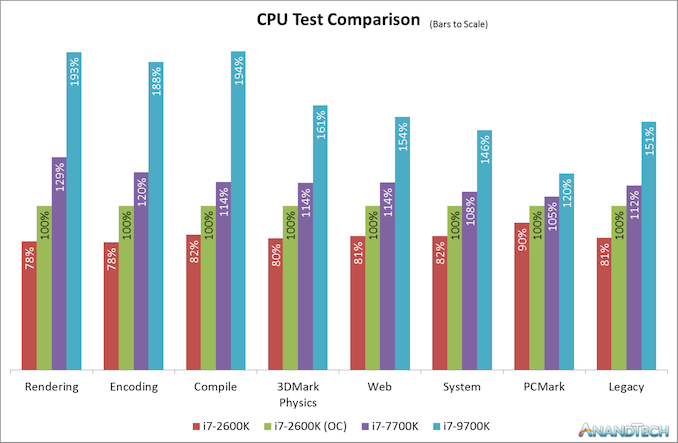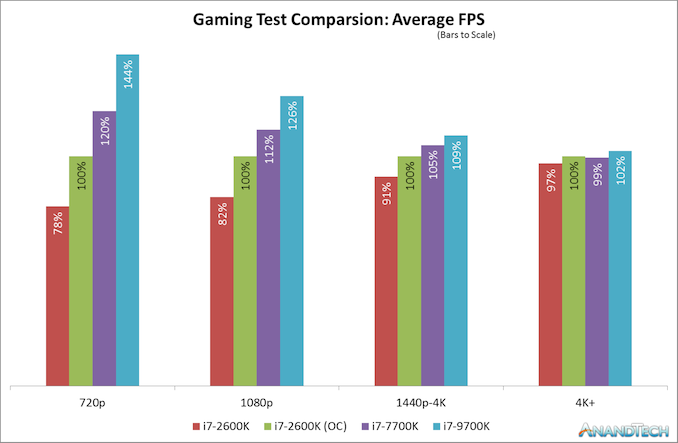Upgrading from an Intel Core i7-2600K: Testing Sandy Bridge in 2019
by Ian Cutress on May 10, 2019 10:30 AM EST- Posted in
- CPUs
- Intel
- Sandy Bridge
- Overclocking
- 7700K
- Coffee Lake
- i7-2600K
- 9700K
Comparing the Quad Cores: CPU Tests
As a straight up comparison between what Intel offered in terms of quad cores, here’s an analysis of all the results for the 2600K, 2600K overclocked, and Intel’s final quad-core with HyperThreading chip for desktop, the 7700K.
On our CPU tests, the Core i7-2600K when overclocked to a 4.7 GHz all-core frequency (and with DDR3-2400 memory) offers anywhere from 10-24% increase in performance against the stock settings with Intel maximum supported frequency memory. Users liked the 2600K because of this – there were sizable gains to be had, and Intel’s immediate replacements to the 2600K didn’t offer the same level of boost or difference in performance.
However, when compared to the Core i7-7700K, Intel’s final quad-core with HyperThreading processor, users were able to get another 8-29% performance on top of that. Depending on the CPU workload, it would be very easy to see how a user could justify getting the latest quad core processor and feeling the benefits for more modern day workloads, such as rendering or encoding, especially given how the gaming market has turned more into a streaming culture. For the more traditional workflows, such as PCMark or our legacy tests, only gains of 5-12% are seen, which is what we would have seen back when some of these newer tests were no longer so relevant.
As for the Core i7-9700K, which has eight full cores and now sits in the spot of Intel’s best Core i7 processor, performance gains are very much more tangible, and almost double in a lot of cases against an overclocked Core i7-2600K (and more than double against one at stock).
The CPU case is clear: Intel’s last quad core with hyperthreading is an obvious upgrade for a 2600K user, even before you overclock it, and the 9700K which is almost the same launch price parity is definitely an easy sell. The gaming side of the equation isn’t so rosy though.
Comparing the Quad Cores: GPU Tests
Modern games today are running at higher resolutions and quality settings than the Core i7-2600K did when it was first launch, as well as new physics features, new APIs, and new gaming engines that can take advantage of the latest advances in CPU instructions as well as CPU-to-GPU connectivity. For our gaming benchmarks, we test with four tests of settings on each game (720p, 1080p, 1440p-4K, and 4K+) using a GTX 1080, which is one of last generations high-end gaming cards, and something that a number of Core i7 users might own for high-end gaming.
When the Core i7-2600K was launched, 1080p gaming was all the rage. I don’t think I purchased a monitor bigger than 1080p until 2012, and before then I was clan gaming on screens that could have been as low as 1366x768. The point here is that with modern games at older resolutions like 1080p, we do see a sizeable gain when the 2600K is overclocked. A 22% gain in frame rates from a 34% overclock sounds more than reasonable to any high-end focused gamer. Intel only managed to improve on that by 12% over the next few years to the Core i7-7700K, relying mostly on frequency gains. It’s not until the 9700K, with more cores and running games that actually know what to do with them, do we see another jump up in performance.
However, all those gains are muted at a higher resolutions setting, such as 1440p. Going from an overclocked 2600K to a brand new 9700K only gives a 9% increase in frame rates for modern games. At an enthusiast 4K setting, the results across the board are almost equal. As resolutions are getting higher, even with modern physics and instructions and APIs, the bulk of the workload is still on the GPU, and even the Core i7-2600K is powerful enough for it. There is the odd title where having the newer chip helps a lot more, but it’s in the minority.
That is, at least on average frame rates. Modern games and modern testing methods now test percentile frame rates, and the results are a little different.
Here the results look a little worse for the Core i7-2600K and a bit better for the Core i7-9700K, but on the whole the broad picture is the same for percentile results as it is for average frame results. In the individual results, we see some odd outliers, such as Ashes of the Singularity which was 15% down on percentiles at 4K for a stock 2600K, but the 9700K was only 6% higher than an overclocked 2600K, but like the average frame rates, it is really title dependent.













213 Comments
View All Comments
Midwayman - Monday, May 13, 2019 - link
I think the biggest thing I noticed moving to a 8700k from a 2600k was the same thing I noticed moving from a core 2 duo to a 2600k. Less weird pauses. The 2600k would get weird hitches in games. System processes would pop up and tank the frame rate for an instant, or just an explosion would trigger a physics event that would make it stutter. I see that a lot less with a couple extra cores and some performance overhead.tmanini - Monday, May 13, 2019 - link
I agree, the user experience is definitely improved in those ways. Granted, many of us think our time is a bit more important than it likely really is. (does waiting 3 seconds really ruin my day?)ochadd - Monday, May 13, 2019 - link
Enjoyed the article very much.Magnus101 - Monday, May 13, 2019 - link
You get about 3Xperformance when going from an upclocked 2600k@4.5GHz to a 8700k@4.5GHz when working in DAW:s (Digital Audio Workstation), i.e running dozens and dozens of virtual instruments and plugins when making music.The thing is that it is a combination of applications that:
1. Use all the SSE/AVX or whatever all the streaming extensions that makes parallell flotaing point calculations go much faster. DAW is all about floating point calculations.
2. Are extremely real-time dependent to get ultra low latency (milliseconds in single digits).
This makes even the 7700 k about double in performance in some scenarios when compared to an equally clocked 2600k.
mikato - Monday, May 13, 2019 - link
"and Intel’s final quad-core with HyperThreading chip for desktop, the 7700K""the Core i7-7700K, Intel’s final quad-core with HyperThreading processor"
Did I miss some big news?
mapesdhs - Monday, May 13, 2019 - link
"... the best chips managed 5.0 GHz or 5.1 GHz in a daily system."Worth noting that with the refined 2700K, *all* of them run fine at 5GHz in a daily system, sensible temps, a TRUE and one fan is plenty for cooling. Threaded performance is identical to a stock 6700K, IPC is identical to a stock 2700X (880 and 177 for CB R15 Nt/1t resp.)
Also, various P67/Z68 mbds support NVMe boot via modded BIOS files. The ROG forum has a selection for ASUS, search for "ASUS bolts4breakfast"; he's added support for the M4E and M4EZ, and I think others asked the same for the Pro Gen3, etc. I'm sure there are equivalent BIOS mod threads for GIgabyte, MSI, etc. My 5GHz 2700K on an M4E has a 1TB SM961 and a 1TB 970 EVO Plus (photo/video archive), though the C-drive is still a venerable Vector 256GB which holds up well even today.
Also, RAM support runs fine with 2133 CL9 on the M4E, which is pretty good (16GB GSkill TridentX, two modules).
However, after using this for a great many years, I do find myself wanting better performance for processing images & video, so I'll likely be stepping up to a Ryzen 3000 system, at least 8 cores.
mapesdhs - Monday, May 13, 2019 - link
Forgot to mention, someting else interesting about SB is the low cost of the sibling SB-E. Would be a laugh to see how all those tests pan with with a 3930K stock/oc'd thrown into the mix. It's a pity good X79 boards are hard to find now given how cheap one can get 3930Ks for these days. If stock performance is ok though, there are some cheap Chinese boards which work pretty well, and some of them do support NVMe boot.tezcan - Monday, May 13, 2019 - link
I am still running 3930k, prices for it are still very high ~$500. Not much cheaper then what I paid for it in 2011. I am yet to really test my GTX 680's in SLI. Kind of a waste, but they are driving many displays throughout my house. There was an article where some Australian bloke guy runs an 8 core sandy bridge - e (server chip) vs all modern intel 8 core chips. It actually had the lowest latency so was best for pro gamers, lagged a little behind on everything else- but definitely good enough.dad_at - Tuesday, May 14, 2019 - link
I run 3960X at ~ 4 GHz on X79 ASUS P9X79 and have nvme boot drive with modified BIOS. So it is really interesting to compare 2011/2012 6c/12t to 8700K or 9900K. I guess it's about 7700K stock, so modern 4c/8t is like old 6c/12t. Per core perf is about 20-30% up on average and this includes higher frequency ... So IPC is only about 15% up: not impressive. Of course in some loads like AVX2 heavy apps IPC could be 50% up, but such case is not common.martixy - Monday, May 13, 2019 - link
Oh man... I just upgraded my 2600K to a 9900K and a couple days later this article drops...The timing is impeccable!
If I ever had a shred of buyer's remorse, the article conclusion eradicated it thoroughly. Give me more FPS.
I saw a screenshot of StarCraft 2. On a mission which I, again, coincidentally (this is uncanny) played today. I can now report that the 9900K can FINALLY feed my graphics card in SC2 properly. With the 2600K I'd be around 20-60 FPS depending on load and intensity of the action. With the new processors, it barely ever drops below 60 and usually hovers around 90FPS. Ingame cinematics also finally run above the "cinematic" 30 FPS I saw on my trusty old 2600K.